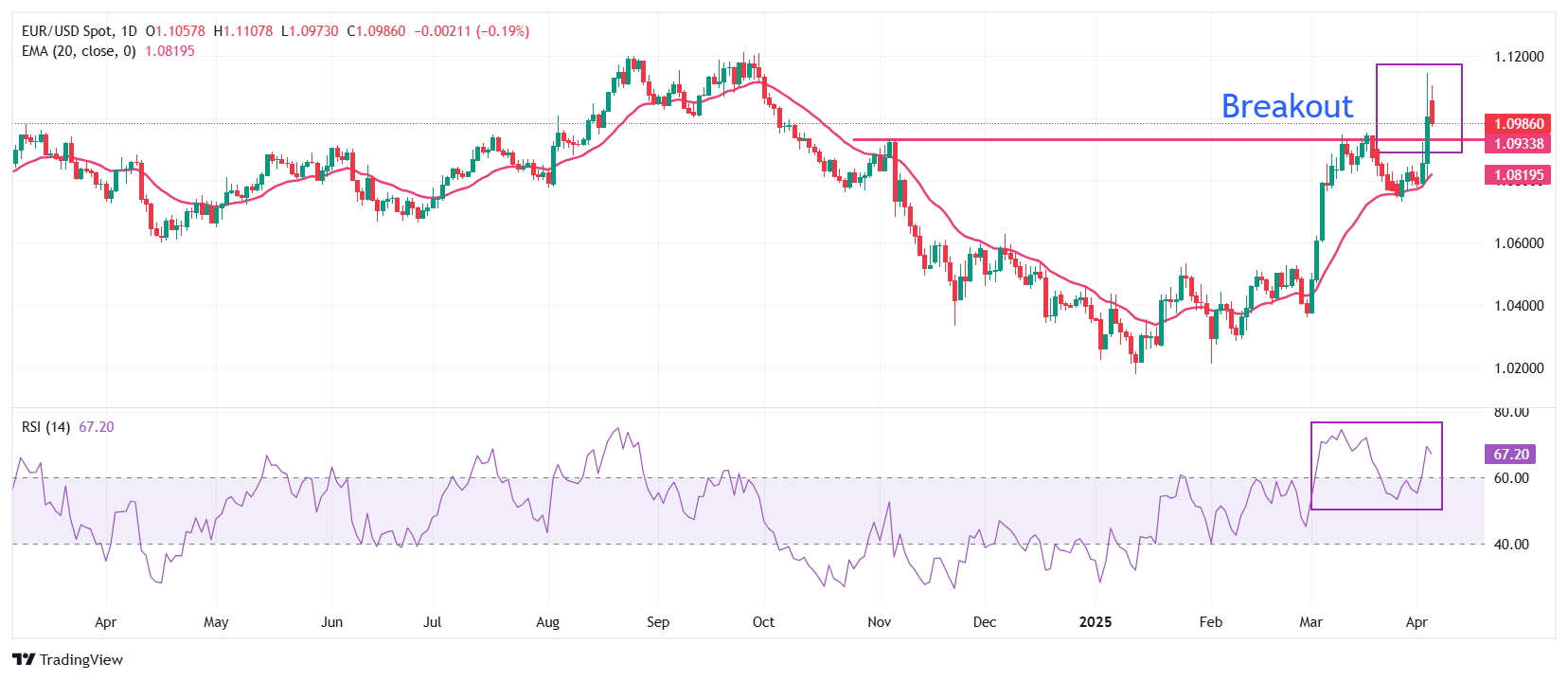Created
: 2025.04.04














![]() 2025.04.04 18:53
2025.04.04 18:53
EUR/USD corrects below 1.1000 during European trading hours on Friday after posting a fresh six-month high at 1.1145 the previous day. The major currency pair retraces as the US Dollar (USD) rebounds after United States (US) President Donald Trump's tariffs-driven sell-off and ahead of the Nonfarm Payrolls (NFP) data for March and Federal Reserve (Fed) Chair Jerome Powell's speech due to in the North American session.
The US Dollar Index (DXY), which tracks the Greenback's value against six major currencies, recovers to near 102.60 from its six-month low of around 101.25.
Economists expect the US economy to have hired 135K fresh workers in March, lower than the 151K in February. The Unemployment Rate is expected to have remained steady at 4.1%. Average Hourly Earnings are estimated to have grown at a slower pace of 3.9% year-on-year compared to the 4% increase seen in February, with monthly figures rising steadily by 0.3%.
The impact of the employment data is expected to be limited on market expectations for the Fed's monetary policy outlook unless there is a dramatic change in labor market figures, as investors are more concerned over potential inflation risks.
According to the CME FedWatch tool, traders have become increasingly confident that the central bank could cut interest rates in the June policy meeting after President Trump announced the reciprocal tariffs. The Fed's probability of keeping interest rates in their current range of 4.25%-4.50% has also diminished to 65.8% from 81.5% recorded a week ago.

EUR/USD gives up some of the prior day's gains and declines to near 1.0970 during European trading hours on Friday. The major currency pair rallied to 1.1147 on Thursday after a decisive breakout above the prior resistance of 1.0955, which is March's highest level. The near-term outlook of the major currency pair remains bullish as the 20-day Exponential Moving Average (EMA) resumes its upward journey, trading around 1.0820.
The 14-day Relative Strength Index (RSI) holds above 60.00, indicating an active bullish momentum.
Looking down, the prior resistance at 1.0955 and the March 31 high of 1.0850 will act as major support zones for the pair. Conversely, the September 25 high of 1.1214 will be the key barrier for the Euro bulls.
The Euro is the currency for the 19 European Union countries that belong to the Eurozone. It is the second most heavily traded currency in the world behind the US Dollar. In 2022, it accounted for 31% of all foreign exchange transactions, with an average daily turnover of over $2.2 trillion a day. EUR/USD is the most heavily traded currency pair in the world, accounting for an estimated 30% off all transactions, followed by EUR/JPY (4%), EUR/GBP (3%) and EUR/AUD (2%).
The European Central Bank (ECB) in Frankfurt, Germany, is the reserve bank for the Eurozone. The ECB sets interest rates and manages monetary policy. The ECB's primary mandate is to maintain price stability, which means either controlling inflation or stimulating growth. Its primary tool is the raising or lowering of interest rates. Relatively high interest rates - or the expectation of higher rates - will usually benefit the Euro and vice versa. The ECB Governing Council makes monetary policy decisions at meetings held eight times a year. Decisions are made by heads of the Eurozone national banks and six permanent members, including the President of the ECB, Christine Lagarde.
Eurozone inflation data, measured by the Harmonized Index of Consumer Prices (HICP), is an important econometric for the Euro. If inflation rises more than expected, especially if above the ECB's 2% target, it obliges the ECB to raise interest rates to bring it back under control. Relatively high interest rates compared to its counterparts will usually benefit the Euro, as it makes the region more attractive as a place for global investors to park their money.
Data releases gauge the health of the economy and can impact on the Euro. Indicators such as GDP, Manufacturing and Services PMIs, employment, and consumer sentiment surveys can all influence the direction of the single currency. A strong economy is good for the Euro. Not only does it attract more foreign investment but it may encourage the ECB to put up interest rates, which will directly strengthen the Euro. Otherwise, if economic data is weak, the Euro is likely to fall. Economic data for the four largest economies in the euro area (Germany, France, Italy and Spain) are especially significant, as they account for 75% of the Eurozone's economy.
Another significant data release for the Euro is the Trade Balance. This indicator measures the difference between what a country earns from its exports and what it spends on imports over a given period. If a country produces highly sought after exports then its currency will gain in value purely from the extra demand created from foreign buyers seeking to purchase these goods. Therefore, a positive net Trade Balance strengthens a currency and vice versa for a negative balance.
![]()
Created
: 2025.04.04
![]()
Last updated
: 2025.04.04

FXStreet is a forex information website, delivering market analysis and news articles 24/7.
It features a number of articles contributed by well-known analysts, in addition to the ones by its editorial team.
Founded in 2000 by Francesc Riverola, a Spanish economist, it has grown to become a world-renowned information website.
We hope you find this article useful. Any comments or suggestions will be greatly appreciated.
We are also looking for writers with extensive experience in forex and crypto to join us.
please contact us at [email protected].
Disclaimer:
All information and content provided on this website is provided for informational purposes only and is not intended to solicit any investment. Although all efforts are made in order to ensure that the information is correct, no guarantee is provided for the accuracy of any content on this website. Any decision made shall be the responsibility of the investor and Myforex does not take any responsibility whatsoever regarding the use of any information provided herein.
The content provided on this website belongs to Myforex and, where stated, the relevant licensors. All rights are reserved by Myforex and the relevant licensors, and no content of this website, whether in full or in part, shall be copied or displayed elsewhere without the explicit written permission of the relevant copyright holder. If you wish to use any part of the content provided on this website, please ensure that you contact Myforex.
Myforex uses cookies to improve the convenience and functionality of this website. This website may include cookies not only by us but also by third parties (advertisers, log analysts, etc.) for the purpose of tracking the activities of users. Cookie policy